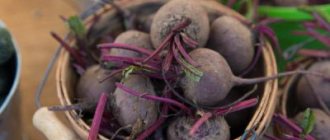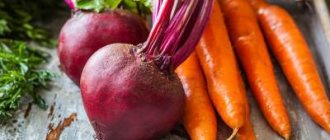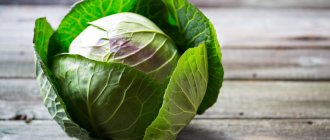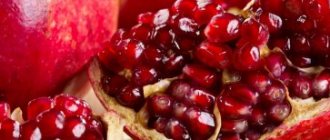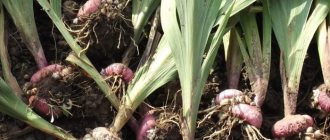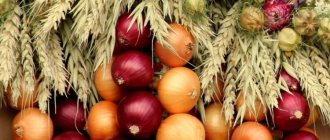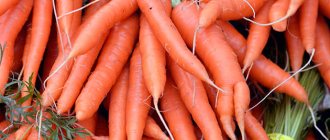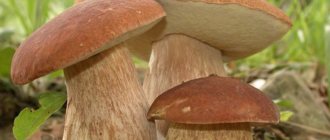Growing vegetables for the winter requires proper organization of their subsequent storage. A careless attitude to this issue can lead to damage to the harvest.
Beets are one of the popular harvested crops, and this vegetable can be stored in the cellar not only until spring, but also until the next harvest.
We will tell you further about how to store beets in a cellar or basement until spring.
Winter storage rules
Planning for planting beets that will need to be stored in the cellar all winter begins with choosing a variety.
It must be suitable for the climatic zone and belong to late- or mid-ripening . The shelf life of such crops is much higher than that of earlier crops.
It is equally important to create conditions in your cellar suitable for storing beets.
Temperature
The temperature in the cellar is one of the very important indicators. For beets, the best option is from 0ºС to +2ºС. If the temperature drops lower, the vegetables may freeze; if the temperature is higher, the beets will begin to sprout, losing moisture, becoming soft and not as tasty.
Humidity
A humidity level of 85% to 90% is suitable for storing beets . This range will not allow the vegetables to rot, and, at the same time, will not allow them to dry out.
Beet description
The culture has a centuries-old history. The root vegetable has long been used for cooking. In the 19th century On the table of the ancient Slavs, beetroot replaced traditional turnips and was used as the main ingredient in many dishes.
Buryak is a perennial plant, but is often grown throughout the country as an annual. Both parts of the plant are used for different purposes. The tops or aerial parts are greenish-brown leaves with large veins. The root crop, located underground, is the most juicy and nutritious part of the plant.
The tops have long been used to prepare traditional Russian cold soups, and the rhizome was considered a raw material for the manufacture of medicinal compositions. After the emergence of various varietal species, the use of plant parts was reconsidered. Leaves and roots began to be used for preparing first and second courses, and also used in the treatment of various diseases.
Buryak is 80% water. 10% is carbohydrates, a small amount of proteins and fats. The peculiarity of the plant is the presence of coarse fiber, which contributes to the natural healing of the body, cleansing it of waste and toxins. Beets are rich in folic acid, which is necessary for full growth and development. The roots and leaves contain high amounts of manganese; this element is difficult to find in plant materials.
Of particular value lies in the increased content of betaine; it has a positive effect on hematopoietic processes, helps to increase the elasticity of blood vessels, which reduces the risk of developing dangerous conditions characterized by cardiac dysfunction. The aerial part is rich in ascorbic acid, essential vitamins and amino acids.
The plant germinates from seeds sown in spring without additional cultivation of seedlings. Harvest occurs at the end of July - mid-August. Some late varieties are harvested in the second half of August or the first half of September. To grow, the crop requires an open sunny area and a temperature range of + 15°. The seeds germinate a few days after planting. The germination rate of planting material prepared taking into account technological methods is quite high. For ripening, it is necessary to carry out regular watering, weeding, and several feedings to improve taste.
The main difficulty after cultivation, when harvesting the crop, is storing beets for the winter in the cellar. If the basic requirements are not met, it becomes soft and loses its beneficial properties. Many gardeners have doubts about this. How to store beets in winter: in the basement or on the balcony. What method to choose for those who do not have the opportunity to store beets in the cellar in winter, taking into account the characteristics of this crop.
Preparing root vegetables
One of the conditions for successfully preserving the harvest is proper preparation of root crops. It includes several stages.
Harvesting
Ripe beets should be harvested correctly. This should be done in such a way that the tubers are damaged as little as possible. To cultivate the beds, forks can be used for digging, and small shovels can be used to remove vegetables. The optimal harvest time is cool, dry weather .
Drying
Vegetables removed from the ground should be thoroughly dried to remove excess moisture. It is best to do this under shelters in warm weather with low humidity. For drying, it will be enough to withstand the crop for several days.
You can tell that the beets have dried out by the condition of the soil that has stuck to them. If lumps of soil easily fall off the tubers without any effort, the beets are ready.
Otherwise, the vegetables are left to lie under the canopy for a little longer. Drying for too long can cause the fruits to begin to wilt , losing moisture.
Removing tops
Beets are sent for storage without tops. To do this, it is cut off, leaving a few centimeters. At the same time, the root crops are shaken off of excess soil. The lower root is not cut off when preparing the harvest.
Sorting
After preparation, the harvested crop should be sorted. It is advisable to select fruits of approximately the same size, without damage, for a long stay in the cellar. Damaged vegetables are not sent for storage . Small ones are poured into a box and used first.
What to do to prevent beets from rotting
Taking care of harvesting and storing crops is a whole science that remains completely unmastered. Sometimes minor factors can affect the safety of root crops. What to do to store beets correctly so that they do not rot or turn black - not every experienced gardener can answer these questions.
One of the secrets to successful storage over time has been consistent adherence to the preparation steps. In order to minimize the risk of rotting, additional measures are taken: the lateral shoots are removed, the tops and the lower root are trimmed. It is on these parts that foci of infection form.
If a rotten specimen is discovered, the vegetables are scattered for inspection, and infected elements located in the neighborhood are discarded. Then they are dried, the tendrils are trimmed if necessary, the material is changed, and the laying is repeated.
How to prepare the storage?
Proper preparation of the cellar room should include high-quality waterproofing and air venting so that optimal humidity and temperature are maintained.
When arranging through holes, protection against rodents must be provided. The purpose of waterproofing is to prevent possible flooding by groundwater and rainwater.
This point must be taken into account at the stage of creating the structure. For example, organizing a good drainage around the perimeter of the building .
Before placing a new crop in the cellar, the room should be inspected and, if necessary, repaired and ventilated. It is also important to remove the remains of last year's harvest and debris. If necessary, treat with bleach for sterilization.
Preparing the cellar for the winter season
Before storing beets, a thrifty owner will definitely check the cellar for ventilation; cold air should freely penetrate into any corner of the storage, and prepare a special storage place for the root crop, raised for better airflow 10-15 centimeters above the floor. Then the cellar should be thoroughly cleaned, the room should be ventilated, and, if desired, the storage facility should be sterilely treated with bleach, followed by whitewashing of the ceiling and walls.
Methods and terms
There are several ways to store beet harvest in the basement. A specific option should be selected taking into account existing conditions and opportunities. Beets are a fairly unpretentious vegetable that can be stored well in the basement not only until spring, but even longer.
Sawdust
Keeping vegetables in sawdust allows you to preserve the harvest for a long time. This method is suitable for finding crops in winter, since sawdust retains heat well. For compactness, you can arrange sides near the storage area in the cellar, or use drawers.
Paper bags
Beets are poured into large paper bags so that 1/3 of the volume remains empty. You should not cover them with anything on top. As in the case of sand, the method is based on the property of paper to absorb moisture . The storage method in bags is suitable for preserving a small harvest.
In sand
To preserve the harvest, boxes or boxes are prepared, bounded by boards, in which the beets are stored sprinkled with sand. Boxes can be not only wooden, but also plastic. But in the latter case, it is important to ensure that they have a sufficient number of holes.
This option is suitable for regions where there are no severe frosts that can lead to freezing of sand and, as a result, damage to root crops.
A layer of sand is poured onto the bottom of the boxes or fences, and beets are laid out on top. And again sand is poured so as to cover the vegetable.
The boxes can be stacked on top of each other in such a way that air access is maintained. In such conditions, root crops can remain for up to a year or even more. The method using sand is based on its ability to absorb excess moisture.
Plastic bags
If space in the cellar is limited, then you can compactly place the harvest by pouring it into large plastic bags . It is necessary to make a sufficient number of holes along their entire surface so that condensation does not appear inside.
You can also add a little sawdust inside the bags to combat moisture. In this package, the vegetable can sit until spring. But it will be necessary to periodically check the condition of the crop to prevent rotting.
Polyethylene is not the best packaging for beets. If possible, it is advisable to use other methods, since vegetables are stored worse in film and may spoil before spring.
If moisture is noticed inside the bags during beet storage, the crop must be dried and placed in another package.
In a heap on the floor
This method of preserving the harvest is the simplest in organization . The beets are laid out in a pyramid on a dry floor pre-treated with a disinfectant. For better preservation, there should be larger vegetables at the bottom, then smaller ones.
The top of the folded pyramid can be covered with straw and earth. In such conditions, the crop can be stored until spring, but it is necessary to control the condition of the root crops.
Wicker baskets
Beets prepared for storage can be placed in large wicker baskets. They can be installed on the floor, on shelves or wooden platforms.
The top of the vegetables can be covered with straw or pine needles . In a non-damp basement without the threat of freezing, the beet harvest in baskets can be stored not only until spring, but even until the next season.
Which beets are stored for a long time?
Beet variety "Crimson Ball"
If beets are not planted for long-term consumption, you can choose a variety regardless of ripening time. Early root crops planted on the site will allow you to enjoy fresh vegetables from the end of July. But such beets are not suitable for winter storage. The delicate thin peel and juicy fiber will quickly lose their elasticity and begin to dry out.
Beets of medium and late ripening are suitable for winter storage:
- Mid-season varieties : Crimson ball, Ideal, Mulatto, Cold-resistant, Bordeaux and others. The ripening period ranges from 80 to 100 days. Harvest in August - September.
- Late-ripening varieties : Torpedo, Cylinder, Odnosprostkovaya and others. Ripening period is from 100 to 135 days. Root crops are harvested from the beginning of September to the end of October. Can be stored until spring.
For each region, you can select beet varieties with a suitable growing season that will have time to ripen before frost. Indeed, unlike carrots, this vegetable is not afraid of rain, but cold and frost are not for it. Therefore, it is worth paying attention to weather forecasts.
Beet variety "Bordeaux"
If we talk about specific varieties of long-term storage, which are very popular among gardeners, the following get good reviews:
- Bordeaux . Seeds are sown at the end of April. The growing season is 4 months. The root vegetables are round and rich burgundy in color. The taste of the pulp is sweet, sugary. Up to 8 kg of beets are harvested per square meter.
- Cylinder . They are planted in May and 4-4.5 months should pass before harvesting. The name of the variety perfectly suits the shape of the root crops: cylindrical, up to 16 cm long. They have excellent taste and high resistance to diseases. Productivity - 10 kg per square meter.
- Mulatto . Ripening period is from 120 to 130 days. Seeds are planted in the ground from late April - early May. Among the advantages of the variety are good yield (up to 5 kg), sweet taste, and unpretentiousness in cultivation.
- Detroit . Ripens in 100–110 days. Beets are planted in April; they are not afraid of cold and return frosts. The fruits are round in shape with juicy softness and have high taste. Productivity up to 7 kg.
- Egyptian flat . It takes up to 130 days from the first shoots to full ripening. The dark red flesh has a delicate taste. Flattened root vegetables are stored until spring. Productivity - up to 8 kg per square meter.
- Single sprout . It takes 130 days to reach full maturity. Beets have a flat-round shape and a pleasant taste. Shelf life under optimal conditions is more than six months.
Don't buy vegetable seeds from random stalls. There is a high probability of purchasing an unknown variety or seeds with expired expiration dates. For shopping, it is better to go to specialized stores.
But no matter how wonderful the variety may be, an untimely harvest and improper preparation of root crops for storage can reduce the best characteristics of the variety to nothing.
How to increase the shelf life of a product?
Despite the fact that beets are vegetables that store well, there are techniques that can be used to further extend the shelf life of the crop and avoid rotting.
Salt
Pre-treatment of root crops with saline solution will help increase the shelf life of harvested beets and prevent the appearance of rot. It is prepared based on the proportion: 10 grams of salt per 1 liter of water.
After processing, the beets are dried and only then sent to the cellar. This technique allows you to extend the shelf life of the product until spring without spoilage .
Phytocides
Plants with a high content of phytocides are natural disinfectants. They prevent the development of pathogenic microflora, including fungi and mold.
These plants include:
- horseradish;
- fern;
- basil;
- sagebrush;
- mint and some other types.
It is very simple to use such plants - they can be used to line the bottom of drawers or put them next to the storage area in the cellar.
Popular ways to preserve beets for the winter
Beets can be successfully preserved from one and a half months to a year at home.
The main thing is to choose a shelf-stable variety, prepare the vegetable for long-term preservation and ensure the correct temperature conditions
Popular storage methods for summer residents:
- Along with potatoes. This is the most popular way to store beets. It is placed directly into bags of potatoes or laid out on top of piles in several layers. At the same time, the beets absorb excess moisture that the potatoes release.
- In sand. This is also one of the most common methods. The fruits in the boxes are sprinkled with sand. Instead of sand, other fillers are used - sawdust, ash, salt, onion peels.
- In polyethylene. Both bags of different sizes and whole cloth are suitable for this.
- In clay. This is an ancient method, proven over centuries, which was used by our grandparents.
- In a refrigerator. Both in its lower part in special containers, and directly frozen in the freezer.
In bags or film
The main condition when storing root vegetables in polyethylene is to ensure air circulation.
Therefore, the bags should not be tied; it is better to leave them open. Or make small holes.
The main condition when storing root vegetables in polyethylene is to ensure air circulation
To prevent humidity from exceeding the required threshold of 96% and condensation from appearing on the film, you can add a little mustard to each bag. As a last resort, sawdust is also suitable for this purpose.
In salt
Vegetables are preserved much better in ordinary table salt than in sand. This is a natural preservative that can preserve the beet harvest almost completely.
Salt prevents the spread of diseases and maintains the required level of humidity.
If you can’t afford to buy a large amount of salt, then you can fully use its beneficial properties by mixing it with sand.
Another way is to make a saline solution, dip the tubers in it one by one, and let them dry. And then put them in boxes with sand.
In sawdust or ash
Sawdust, especially from coniferous trees, can protect the crop from disease. The phytoncides contained in sawdust can kill pathogenic bacteria and destroy fungi.
Storing beets in sawdust
A natural “preservative” is stove ash. Before using it for its intended purpose, it must be sifted through a fine-mesh sieve.
In the peels of garlic or onions
Instead of sawdust, you can use onion and garlic peels. This is an excellent covering material that disinfects the surface of the fruit.
At the same time, the tubers should be placed in canvas bags so that the husks do not leak.
Dipping into clay mash
This method has been known for a very long time, and therefore is very effective and completely harmless. The clay should first be sifted through a construction sieve to avoid lumps.
Then dilute it with water so that you get a mass that is similar in thickness to sour cream. The fruits are dipped into it one by one. Then they are sent to dry.
Read more ► How to keep peppers fresh in winter?
You need to make sure that the clay dries completely and only then send the harvest to the cellar. Clay completely covering the fruit prevents it from becoming infected with rot and prevents moisture evaporation.
In sand
For storing root vegetables in the cellar, it is best to choose loamy sand. It stops excessive evaporation of precious moisture. Prevents the spread of diseases.
Maintain the desired temperature. Before pouring sand into boxes and placing crops in it, it should be moistened. To do this, mix it with water.
The tops of root crops are always removed.
The calculation is this: a bucket of sand uses a liter of water. You can check the moisture content by squeezing a handful of sand in your palm. If it doesn’t crumble and remains a lump, it means it’s ready.
First, sand covers the bottom of pre-prepared boxes. Then they begin to lay out the vegetables so that they do not touch each other.
Next, add a layer of sand, isolating one layer of tubers from the other until the box is completely filled.
Possible problems and ways to solve them
When organizing the storage of beets in the cellar until spring, you may encounter a number of problems:
| Problem | Ways to solve the problem |
| After harvesting beets, it rains, which prevents the vegetable from drying quickly | If the weather is rainy, it may take a few more days to dry. |
| An unpleasant odor appears in the cellar | The reason may be a violation of containment conditions or improper preparation. If there is a smell of rot, the crop should be sorted, removing spoiled root crops. You should also check the condition of ventilation, and whether there are fruits and vegetables adjacent to the beets, which impair its keeping quality. |
| Frozen vegetables | They cannot be sent for storage |
| Phimosis | Violation of the rules for growing vegetables, for example, excess fertilizer or poor watering. Cannot be sent for long-term storage |
| Fungal infection of fruits | The cellar will need disinfection |
| Germination of tops | The temperature regime in the basement is disturbed, the temperature is too high |
Conditions for storing beets in the cellar
Proper storage of beets in the cellar becomes possible only if there are good conditions. Before you put root crops in the basement, you need to make sure that the room is suitable for them in terms of temperature and humidity.
Beetroot grows best in winter at temperatures from 0 to 2 °C. If the basement is warmer, the vegetable will begin to dry out and sprout. If the temperature is lower, the fruits will freeze and lose their juiciness and pleasant taste.
The optimal humidity for the crop is 85-90%. In such conditions, the crop does not dry out, but does not rot. At the same time, good ventilation must be maintained in the cellar, since fungi and mold quickly develop in musty conditions.
Like most vegetables, beets collected from garden beds do not like sunlight - they need to be stored in the dark
Shelf life
How long it will be possible to store beets in the basement in winter directly depends on the conditions and the initial quality of the fruit. If the vegetables are ripe and juicy, without damage or signs of rotting, and the temperature and humidity in the cellar meet all the requirements, the harvest can last up to two years.
Most often, the culture retains its taste and beneficial properties for 6-9 months, since it is quite difficult to provide ideal conditions. But even such terms are very good - most vegetables begin to spoil earlier.
Which vegetables and fruits can be nearby and which cannot?
Storing vegetables and fruits together in the same basement is often very difficult. When placing beets, you can organize their successful proximity to potatoes .
In a joint planting, potatoes should form the bottom layer, and beets should form the top. In this case, it is better to keep carrots separately, as they contribute to the rapid spoilage of beets. Suitable companions for storing beets together in the same cellar are onions and garlic.
Little tricks for storing a big harvest
A few more tips:
- Before pouring sand into the boxes with beets, bake it in the sun. Excess moisture will evaporate from it.
- Root vegetables can be rolled in wood ash before storing. This will protect them from pests.
- Large beets spoil faster than small ones. When placing in boxes or bags, place small root vegetables at the very bottom and large ones on top of them.
Recommendations
When storing harvested beets for a long time, it is important to remember the basic advice of experts:
You cannot dry vegetables in the sun - only under a canopy, in a draft.- Storage containers should not interfere with good ventilation.
- The cellar should not be stuffy and damp.
- The harvest in storage should be sorted every 15-20 days during the entire period of being in the cellar.
- Beets should not be washed before storing - just shake off the soil from them.
- Digging up beets too early will prevent the root crops from accumulating enough nutrients and will reduce their nutritional value.
Harvest
The shelf life of a vegetable can be affected by the harvesting process. The root crop is located underground, so you need to choose a day when the weather is warm and sunny.
Important! If the fruit freezes, the damaged area will begin to deteriorate, and storing the vegetable will be problematic.
The collection technology itself is also important. You need to do all the work as carefully as possible so as not to damage the root crop. Using a pitchfork or shovel, carefully dig up the soil under the vegetable and just as carefully pull the root vegetable out of the ground by the tops.
In this video you will learn more about storing beets:
Factors affecting crop safety
Keeping quality largely depends on agricultural technology, which includes a complex of factors: timing of sowing and harvesting, soil preparation and tillage, watering and fertilizers.
Agricultural technology:
- for beets, prepare the soil with a neutral reaction;
- on heavy soils, deep autumn digging, the introduction of humus and the complete removal of all plant residues are recommended;
- carry out sowing at the optimal time;
- loosen and break through the seedlings to create a suitable microclimate for development.
Do you know that…
During storage, the greatest damage to beets is caused by diseases: downy mildew, fomoz or black rot. To prevent their spread, it is necessary to constantly remove infected copies.
